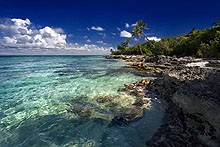Where Is Dominica and What
Is It Known For?
Answer:

Beautiful Dominica beach with palm trees.
|
Dominica, officially the Commonwealth of Dominica, is the most northerly of the Windward Islands, in the eastern Caribbean. To the north-northwest lies Guadeloupe, to the southeast Martinique. Its size is 754 square kilometres (291 sq mi) and the highest point in the country is Morne Diablotins, which has an elevation of 1,447 metres (4,747 ft). The Commonwealth of Dominica has an estimated population of 72,500. The capital is Roseau; approximately a quarter of Dominicans live in the capital.
Dominica has been nicknamed the "Nature Isle of the Caribbean" for its seemingly unspoiled natural beauty. It is the youngest island in the Lesser Antilles, still being formed by geothermal-volcanic activity, as evidenced by the world's second-largest boiling lake. The climate is tropical and rainfall is abundant. It is very mountainous and forested, with a coastline of steep cliffs, and home of many rare plant, animal, and bird species. There are xeric areas in some of the western coastal regions, but heavy rainfall can be expected inland. The Sisserou Parrot (also known as the Imperial Amazon), the island's national bird, is featured on the national flag. The economy is based on agriculture with bananas (the major export) coconuts and citrus fruits the most important crops. Tourism is a developing industry.
Christopher Columbus named the island after the day of the week on which he spotted it, a Sunday (dominica in Latin), November 3, 1493. In the next hundred years after Columbus' landing, Dominica remained isolated, and even more Caribs settled there after being driven from surrounding islands as European powers entered the region. France formally ceded possession of Dominica to the United Kingdom in 1763. The United Kingdom then set up a government and made the island a colony in 1805.
The emancipation of African slaves occurred throughout the British Empire in 1834, and, in 1838, Dominica became the first British Caribbean colony to have a legislature controlled by an African majority. In 1896, the United Kingdom reassumed governmental control of Dominica, turning it into a Crown colony. Half a century later, from 1958 to 1962, Dominica became a province of the short-lived West Indies Federation. In 1978, Dominica became an independent nation.
|